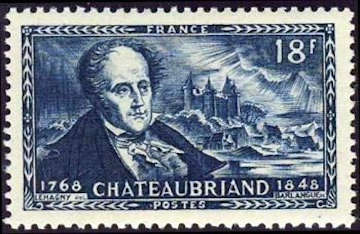TIMBRES DE FRANCE
Ex : 50 c
Ex : 456
Ex : Appel du 18 juin
Ex : 1900
Ex : Femme
mini 4 lettres
Création du site : Juillet 2005
Nombre de visiteurs : 34.188.429
Nombre de pages : 112.789.268
Dernière mise à jour 26-03-2025
Nombre de visiteurs : 34.188.429
Nombre de pages : 112.789.268
Dernière mise à jour 26-03-2025
Cette bannière est une publicité le site n'a aucune boutique de vente
Les informations sur ce timbre ont été mises à jour le : 20/10/2024

François René de Châteaubriand (1768-1848) homme d'État français
Timbre : Courant / moderne
Voir tous les timbres courants de l'année 1948
Listage des timbres de l'année 1948




Vente générale : 3 juillet 1948
Retrait de la vente : 4 décembre 1948
Valeur faciale : 18 f
Graveur : Gabriel Antonin Barlangue
Dessinateur : Gabriel Antoin Barlangue
Département concerné par ce timbre : Meurthe-et-Moselle
Dentelure : Dentelé 13
Couleur : bleu
Mode d'impression : Taille douce
Format du timbre : 40 x 26 mm (vignette 36 x 21,45 mm bords externes des filets)
Quantité émis : 2.480.000
Présentation : Feuille de 50 timbres
Bande phosphore : Sans
Catalogue Yvert et Tellier France : N° 816
Catalogue Spink / Maury France : N° 816
Catalogue Michel : N° FR 827
Catalogue Scott : N° FR 603
Valeur marchande timbre neuf avec gomme intacte: 0,15 €
Valeur marchande timbre neuf avec charnière : 0,10 €
Valeur marchande timbre oblitéré : 0,10 €
La valeur marchande représente une valeur de base du timbre pour la vente ou l'échange
Thématique catégorie : Poètes, écrivains, philosophes, historiens
Informations sur le sujet du timbre
François-René, vicomte de Chateaubriand
(1768-1848). Destiné d'abord à la carrière de marin, conformément à la tradition familiale, il était par tempérament tenté bien davantage par la prêtrise et par la poésie. Revenu de son voyage en Amérique (1826) à Saint-Malo au début de l'année 1792, il se marie puis, émigre et rejoint en Allemagne l'armée contre-révolutionnaire. De retour en France en 1800, Chateaubriand, affecté par la mort de sa mère et de l'une de ses soeurs, se tourne vers la foi catholique dont il s'était écarté. Dans cet état d'esprit parait, les Natchez : Atala, ou les Amours de deux sauvages...lire la suite
François-René, Viscount of Chateaubriand
(1768-1848). Destined first for the career of a sailor, in accordance with family tradition, he was by temperament much more tempted by the priesthood and by poetry. Returning from his trip to America (1826) in Saint-Malo at the beginning of 1792, he married and then emigrated and joined the counter-revolutionary army in Germany. Back in France in 1800, Chateaubriand, affected by the death of his mother and one of his sisters, turned to the Catholic faith from which he had departed. In this state of mind, the Natchez: Atala, or the Loves of two savages in the desert (1801). Chateaubriand becomes the writer of faith and meets Mme Récanier who will become the love of his life. Appointed secretary of the embassy in Rome (1803), he became enthusiastic about Italian landscapes but resigned after the execution of the duke of Enghien (1804). He retired to his home in the Vallée-aux-Loups, near Sceaux, and began writing the Memoirs d'outre-tombe, which lasted about thirty years. He is elected to the French Academy in 1811, the year of the publication of his Itinerary from Paris to Jerusalem. But after an attempt to conspire with the Duchess of Berry against Louis-Philippe (1834), he abandoned political life. He composed the Vie de Rancé (1844). However, his health is declining , he died in Paris on 4 July 1848 and was buried on 19 July, according to his last wishes, on the rock of Grand-Bé, in the harbour of Saint-MaloSource : various Internet documents including Wikipedia
Cette page a été visitée 14 311 198 fois depuis le 1er mai 2022
